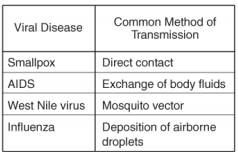Tip
Tap
a student's name
below to see what they need help with5 questions
Q.How does a virus cause disease?
1
30 sec
Q.Viruses can be transmitted in a variety of ways. The virus that causes SARS (severe acute respiratory syndrome) can be transmitted when an infected person coughs or sneezes. This virus is transmitted in a manner most similar to the transmission of—
2
30 sec
Q.Which of the following is effective in reducing the number of viral infections?
3
30 sec
Q.A person infected with the human immunodeficiency virus (HIV) may not have any symptoms for a period of time. During this period the virus affects the body by doing which of the following?
4
30 sec
Q.Severe acute respiratory syndrome (SARS) is an illness caused by a coronavirus. Symptoms including a high fever, headaches, and body aches typically occur two to seven days after infection by the virus. SARS is more serious in elderly patients. This information suggests that the reproductive cycle of the SARS virus is —
5
30 sec


